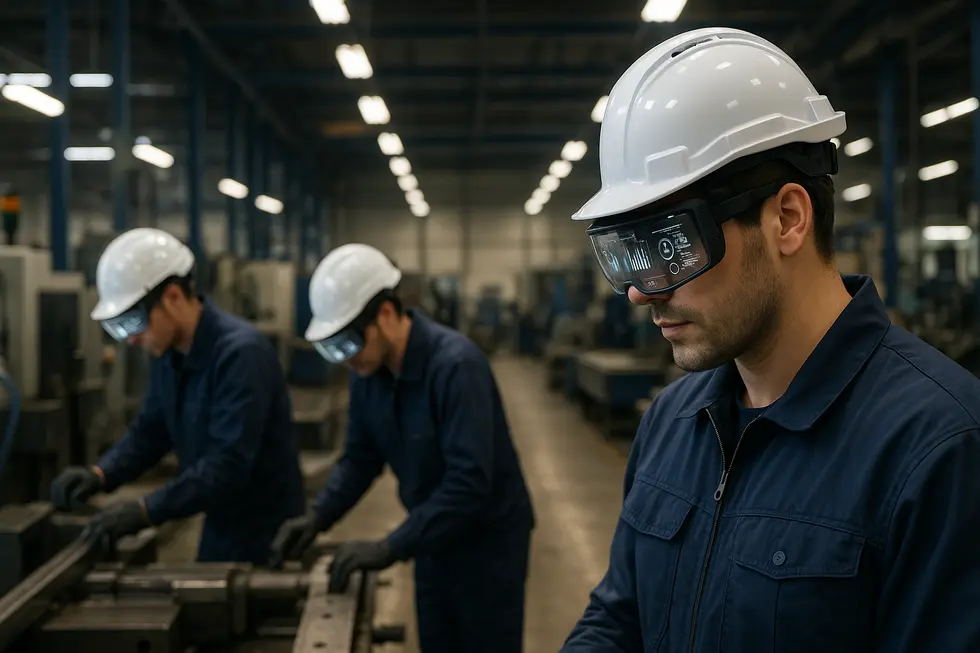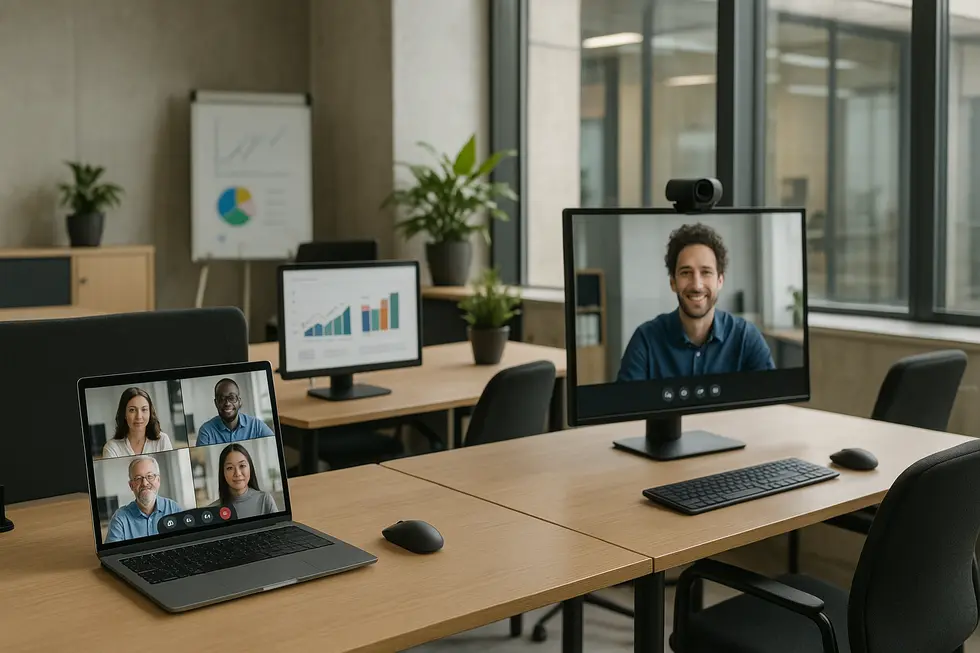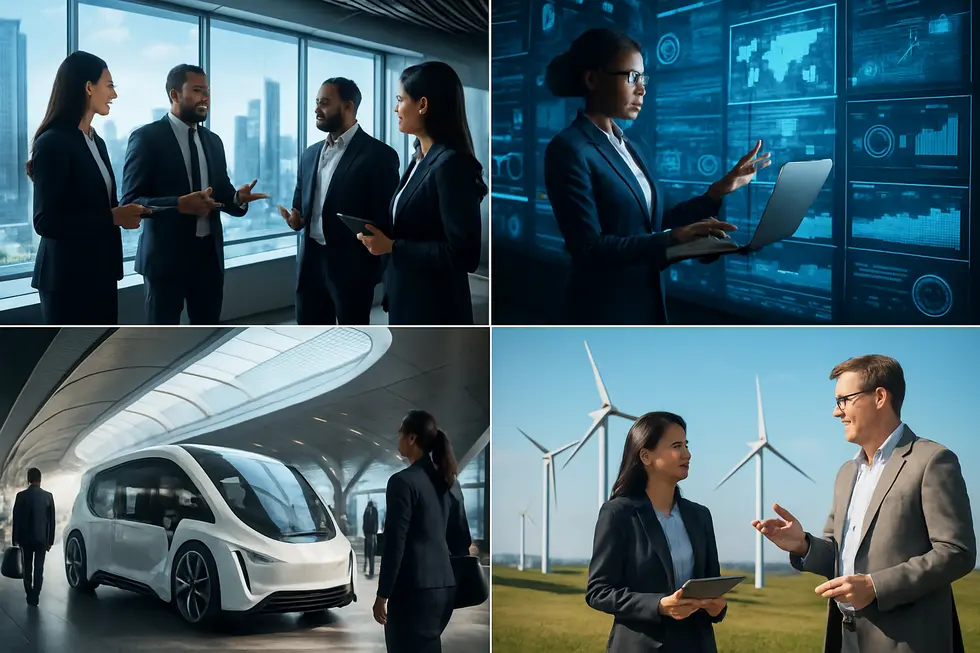The Rise of Smart Hardware in Industries Beyond Consumer Electronics: 5 business trends no one talks about – but everyone should

1. Harnessing Edge AI: How Real-Time Industrial Intelligence Is Revolutionizing Smart Hardware Applications
Smart hardware is no longer confined to consumer gadgets. The integration of Edge AI is transforming industrial sectors by enabling real-time processing at the very source of data generation. This shift eliminates reliance on distant cloud servers for immediate insights, reducing latency and enhancing operational responsiveness. Industries such as manufacturing, construction, and healthcare are applying this approach to optimize safety, productivity, and maintenance.
Edge AI empowers ultra-compact devices through innovations like TinyML, allowing low-power hardware to execute sophisticated AI models locally. This capability is crucial for predictive maintenance systems that forecast equipment failures before costly breakdowns occur. The immediacy of decisions enabled by edge processing drives not only efficiency but also substantial cost savings by minimizing downtime and streamlining resource allocation.
Security and privacy concerns in industrial AI are addressed by federated learning, which trains AI models across decentralized devices without exchanging raw data. This distributed intelligence fosters collaboration among machines while adhering to stringent data governance demands, especially critical in sensitive environments.
Moreover, edge-cloud orchestration orchestrates seamless interplay between localized AI and cloud ecosystems. This hybrid architecture leverages fast device-level analysis while enabling centralized long-term data insights, supporting complex industrial workflows and strategic planning.
The combination of these advances fosters smarter, more autonomous industrial environments where data-driven decisions happen instantly on-site. Businesses prepared to adopt this convergence will gain a decisive edge in operational excellence.
Explore further the cutting-edge movement of AI innovations in edge devices that are redefining industrial smart hardware solutions.
2. Advancing Smart Hardware Beyond Consumer Electronics: How Materials Innovation and Connectivity Fuel Sustainable Industry 4.0
The transformation of industrial sectors through smart hardware extends far beyond consumer electronics. Central to this shift is the adoption of innovative materials and connectivity technologies that enhance adaptability, performance, and environmental responsibility. Modular and configurable manufacturing lines are becoming essential, enabling industries to swiftly adjust production in response to dynamic market needs. This flexibility is supported by AI-driven hardware requiring advanced silicon capable of executing complex algorithms directly on the factory floor. Governments worldwide recognize this necessity, investing heavily in semiconductor development to fuel smart manufacturing’s progress.
Connectivity forms the backbone of this evolution, with the convergence of IT and OT systems breaking down traditional silos. This fusion not only streamlines operations but also elevates cybersecurity standards critical to protecting increasingly interconnected industrial networks. Emerging protocols like Single Pair Ethernet and convergent Time-Sensitive Networking (TSN) offer low-latency, reliable data exchange essential for real-time industrial applications and the Industrial Internet of Things. These advancements empower factories with deterministic communication channels, boosting efficiency and responsiveness.
Sustainability increasingly underpins hardware design and manufacturing strategies. Industries embrace energy-efficient technologies and sustainable production methods that reduce environmental impact throughout the hardware lifecycle. Warehouse automation also reflects this trend, focusing on minimizing waste and optimizing resource use within logistics. This integrated approach ensures smart hardware solutions not only advance operational capabilities but also align with growing ecological expectations.
The convergence of cutting-edge materials, robust connectivity, and sustainability efforts marks a crucial leap toward resilient, efficient, and eco-conscious industrial ecosystems. For businesses aiming to thrive, understanding how these elements interact is vital. More on these pivotal industrial innovations can be found at IEB Media’s special report on industrial connectivity.
Evolution of Home Automation into Integrated Living Ecosystems: 5 business trends no one talks about – but everyone should

1. Harnessing Seamless AI Integration for a Personalized and Sustainable Smart Home Experience
The transformation of home automation into integrated living ecosystems is reshaping modern lifestyles through seamless connectivity and AI-driven intelligence. Rather than isolated gadgets, homes now operate as cohesive environments where lighting, climate, security, entertainment, and appliances communicate effortlessly via unified platforms. Artificial intelligence underpins this evolution by adapting systems to individual behaviors and preferences, creating truly personalized living experiences.
AI-driven customer service tools embedded within smart home setups further enhance convenience by anticipating needs and simplifying interaction. Beyond comfort, these smart ecosystems prioritize energy efficiency — AI-powered thermostats and lighting automatically optimize consumption based on occupancy and environmental conditions, significantly reducing waste and boosting sustainability. This shift responds to increasing consumer demand for eco-friendly solutions, integrating sustainability deeply into everyday living.
Luxury smart homes exemplify this trend, benefitting from highly integrated control systems that harmonize comfort and security in a single interface. The ability to manage diverse systems effortlessly elevates lifestyle quality while demonstrating the market’s growing sophistication.
Governmental smart city initiatives also contribute, fostering infrastructure and policy frameworks that accelerate the adoption of integrated living ecosystems, particularly in rapidly urbanizing regions. This support shapes a future where smart homes are integral parts of sustainable, connected communities.
The convergence of AI with IoT and sustainable technologies is driving the smart home market toward unprecedented growth, expected to exceed billions globally in the near future. Embracing these advancements will be essential for businesses aiming to innovate in home automation sectors.
For further insight into current home service innovations, see the upcoming major home service trends.
2. Harnessing Sustainability, Intelligent Data Management, and Interoperability to Transform Home Automation Ecosystems
Sustainability, Data Intelligence, and Unified Control: Key Drivers Shaping Integrated Living Ecosystems
Home automation is rapidly advancing beyond isolated convenience tools into fully integrated living ecosystems that prioritize sustainability, intelligent data use, and seamless device interoperability. Sustainability now sits at the heart of this evolution as consumers demand energy-efficient homes that minimize environmental impact. Smart systems continuously monitor consumption patterns and adjust usage proactively to reduce waste. This active optimization aligns with growing ecological awareness and regulatory support globally, especially in regions where urbanization fuels smart home adoption focused on green living.
Simultaneously, the enormous volume of data generated by smart devices is leveraged through advanced analytics and artificial intelligence. This intelligent data management enables predictive maintenance, real-time energy optimization, and personalized automation that adapts to the unique rhythms of household occupants. Businesses adopting these capabilities gain differentiation by offering sophisticated, user-centric services that improve comfort and efficiency.
Perhaps the most transformative element is the drive toward interoperability across disparate smart devices. Users expect a seamless experience where lighting, climate controls, security, and entertainment systems communicate effortlessly under a single intuitive interface. This unified ecosystem simplifies control and amplifies the value of smart homes. Luxury markets exemplify this trend with integrated systems that deliver convenience, security, and elegance combined.
Together, sustainability, data-driven management, and interoperability create a new paradigm for home automation. Businesses that embrace these intertwined trends position themselves to meet evolving consumer expectations while advancing operational efficiency and environmental stewardship.
For deeper insights on smart home sector developments, exploring GCC Smart Home Market Trends provides valuable context. Additionally, the modern funnel conversation guides understanding how evolving customer decision journeys affect technology adoption in homes.
Agentic AI Driving Next-Level Business Intelligence and Data Governance: 5 business trends no one talks about – but everyone should

1. How Agentic AI Transforms Business Intelligence and Compliance Across Industries
Agentic AI marks a revolution in business intelligence and data governance by moving beyond passive data analysis to autonomous, intelligent decision-making. Unlike traditional AI systems, agentic AI possesses the autonomy to act and adapt in complex environments, enabling businesses to automate entire workflows and respond dynamically without constant human intervention. This shift empowers organizations to uncover deeper insights, streamline operations, and maintain compliance proactively.
One compelling application lies in human resources, where agentic AI expedites recruitment by autonomously screening candidates, scheduling interviews, and onboarding employees. This automation lightens HR workloads and accelerates talent acquisition while maintaining consistency and fairness. Similarly, in financial management, agentic AI automates invoice processing, approval workflows, and fraud detection with high precision. By continuously learning from data patterns, it identifies subtle anomalies that suggest fraudulent activity, providing a robust shield against financial risks.
Beyond these, cybersecurity benefits immensely as agentic AI monitors complex network data in real-time, swiftly detecting threats and triggering automated response protocols. This rapid, autonomous defense is crucial to combating sophisticated cyberattacks that conventional tools might miss or respond to too slowly. On the strategic front, agentic AI can independently analyze market and operational data to guide business intelligence efforts, enabling companies to anticipate trends and make agile, data-driven decisions.
Crucially, agentic AI enforces data governance by continuously auditing data access, ensuring regulatory compliance, and promptly addressing breaches. This capability is essential as data privacy regulations tighten and organizations manage increasingly vast data ecosystems.
Together, these industry-specific applications reveal how agentic AI is becoming the backbone of intelligent, compliant, and autonomous business operations. Exploring how to harness this technology can unlock significant competitive advantage as enterprises seek to evolve their intelligence and governance frameworks.
For more on how AI agents differ from mere automation and their impact on business processes, see this detailed discussion on AI Agents vs AI Automations.
Learn more from Microsoft’s insights into the emerging age of AI agents here.
2. Beyond Automation: How AI-Driven Data Governance and Generative AI Reshape Trust and Compliance in Business Intelligence
AI-powered business intelligence is no longer just about automated reporting or faster analytics—it’s evolving into a robust ecosystem where AI-driven data governance plays a central role. One of the most transformative trends is the proactive integration of governance into the very fabric of product and model development. This approach ensures that AI models are inherently auditable, explainable, and compliant before they hit the market, reducing risks and building trustworthy relationships with stakeholders.
As regulatory environments tighten, companies face increasing complexity in compliance demands. Static, periodic checks no longer suffice. Instead, enterprises are adopting real-time compliance monitoring tools that continuously scan data flows and AI outputs to align with evolving laws and policies. This dynamic vigilance minimizes disruptions and legal exposure, turning governance into a live, adaptive process.
Concurrently, data ownership is decentralizing. Business units and domain experts now govern their own datasets under unified policies, accelerating innovation and responsiveness while requiring new frameworks for accountability. This shift empowers those closest to the data to make more informed decisions without bottlenecks.
Privacy-first design principles are also reshaping AI-powered BI. Rather than treating privacy as an afterthought, companies embed protections at every stage of data handling—from collection to storage and eventual deletion. This commitment safeguards sensitive information and reinforces customer confidence.
Finally, cross-industry collaborative governance models are emerging as businesses confront fragmented legal landscapes. Through partnerships, companies standardize ethical AI practices, sharing tools and expertise to handle generative AI’s role in BI dashboards and automated insights responsibly. These alliances foster transparency and help businesses navigate the ethical complexities of AI together.
Together, these trends underscore how generative AI extends beyond automation to enable intelligent, responsible, and trustworthy business intelligence. For businesses seeking to stay ahead, embracing this holistic approach to AI governance is essential.
You can explore more about strategic data governance trends shaping the future at Governata’s insights on data governance.
For additional insights on automating business processes with AI, consider reading about 5 magical ways to streamline your business with process automation.
Hybrid Work Models and Remote Work Innovations: 5 Business Trends No One Talks About – But Everyone Should

1. Unleashing Global Talent and AI Integration: The Hidden Engines Driving Hybrid Work’s Evolution
Hybrid work is redefining how businesses attract talent and integrate technology to maintain competitive edge. More than a flexible schedule, hybrid models enable companies to tap into a worldwide talent pool, breaking down geographic barriers that once limited hiring to local or regional candidates. This expansion allows organizations to diversify skills and perspectives, fostering innovation and creativity essential for today’s dynamic markets.
The success of hybrid work hinges on seamless technology integration. Artificial intelligence and automation optimize processes, from intelligent scheduling to real-time collaboration tools that bridge the physical distance between dispersed teams. These technologies streamline workflow management and reduce friction in communication, enhancing productivity without sacrificing flexibility. Automation also underpins IT management, ensuring systems operate smoothly, allowing employees to concentrate on value-added tasks.
As businesses adopt hybrid models, the combined effect of global talent access and advanced AI-driven technology enables a new paradigm of work. Teams become more agile, inclusive, and capable of delivering complex projects without compromising connectivity or culture. This synergy supports a fresh organizational dynamic where innovation thrives through diversity and technological empowerment, positioning companies to adapt and excel amid evolving workforce expectations.
For a richer understanding of how AI shapes workplace transformation, explore insights from this detailed exploration of artificial intelligence in the modern office. To keep pace with the evolving hybrid work landscape, visit Splashtop’s remote work trends for 2025.
2. Immersive Collaboration, Personalized Engagement, and Recruitment Revolution in Hybrid Work
Hybrid work models continue to redefine traditional office norms by integrating immersive technologies, adaptive employee engagement, and evolving recruitment approaches. Virtual Reality (VR) and Augmented Reality (AR) are becoming essential in bridging the gap between remote workers and in-office teams. These technologies create highly interactive and immersive virtual meeting spaces that simulate face-to-face encounters, enabling more authentic collaboration and social connection. Beyond meetings, VR and AR enhance training and team-building exercises, fostering a deeper sense of community despite physical distance.
Alongside technological innovation, personalized employee engagement strategies are gaining prominence. In hybrid environments, a one-size-fits-all approach no longer suffices. Tailoring communication styles, feedback mechanisms, and work settings to individual needs boosts satisfaction and productivity. This customization is often powered by AI-driven analytics capable of reading employee sentiment and behavior patterns, allowing leaders to respond with targeted initiatives. Flexibility in work hours and methods becomes a pivotal component, respecting diverse preferences and life circumstances.
Recruitment practices are also undergoing a profound transformation spurred by the demand for flexible work options. Candidates now prioritize roles offering hybrid or fully remote opportunities, pushing companies to highlight their adaptability in job offers. This shift widens the talent pool and enhances overall workforce wellbeing but introduces complexities such as cross-jurisdictional compliance. Consequently, recruitment strategies evolve to emphasize not only flexibility but also technological integration that streamlines candidate experience and talent management.
This triad of immersive technologies, personalized engagement, and recruitment evolution embodies the next wave of hybrid work innovation, empowering organizations to attract and retain talent while cultivating productive, connected workplaces. For a deeper dive into these transformative strategies, explore how businesses enhance employee engagement through hybrid models in this insightful research.
Final thoughts
As we navigate a rapidly transforming business landscape, these under-the-radar trends present significant opportunities and challenges. By leveraging smart hardware, embracing integrated home ecosystems, adopting AI-driven business intelligence, and navigating hybrid work models, small and medium-sized businesses can position themselves at the forefront of innovation. Recognizing and adapting to these trends can provide a competitive edge and prepare businesses for the future.
Not sure where to start? Browse all our AI Agents and discover what’s possible with vaiaverse Level 2.
About us
vaiaverse is the home of next-generation AI agents – digital employees that handle real business tasks across lead generation, sales, and customer support. Whether it’s qualifying leads by phone, answering common questions over WhatsApp, or managing follow-ups by email, our ready-made and bespoke AI Agents are built to save time, cut costs, and scale your operations without hiring. From simple drag-and-drop onboarding to advanced AI teams with SLAs – vaiaverse offers flexible solutions for companies ready to automate what slows them down and double down on what drives growth.









